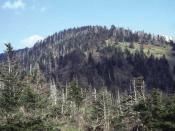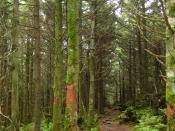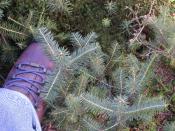On the highest peaks of the Appalachian Mountains, there are spruce fir forests, which are predominately made up of Red Spruce and Fraser Fir (Smith and Nicholas 1998). In the past several decades scientists have been noticing an unusually large number of Red Spruce and Fraser fir dying, much more than what should be. This finding was a cause for concern, therefore, over the past two decades there has been rigorous research done on these trees; and the more research that was done the more evidence they found that linked air pollution with the mortality of these trees (Mello 1987). Air pollution is the main reason for tree mortality among the Red Spruce and the Fraser fir. The onset of modern air pollution has caused many problems for the trees in the form of acid deposition, changes in nutrient ratios, and weakening trees to insect defoliation, as well as harsh weather conditions.
The Red Spruce is an evergreen with a thick coat of dark green needles. The Red Spruce is named for its "cylindrical reddish brown cones" and can grow to be about one hundred feet tall. Its habitat is most commonly the Appalachian Mountains of Western North Carolina, Eastern Tennessee and Southwestern Virginia, at elevations of about 4500 to 6500, because it requires a cool and wet climate to survive. This tree was at one time a very valuable softwood because the paper industry and the construction industry relied on it for timber and pulp to make paper (Mello 1987). The Fraser fir, also known as the southern balsam fir, is native to the high elevations of the Southern Appalachian Mountains (Woolsey and Butcher 1998). These trees serve the important purpose of watershed protection, since "they hold the shallow soil to the steep wet slopes." They are also...



Kind of boring
it starts of good but then goes down hill
5 out of 6 people found this comment useful.